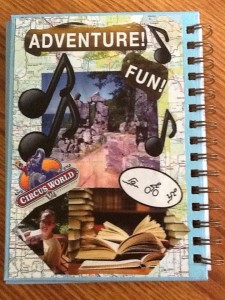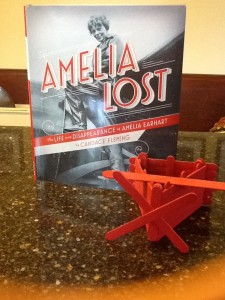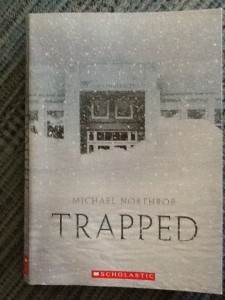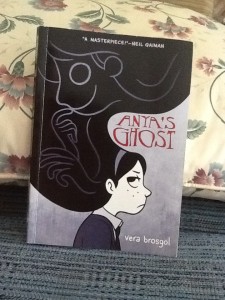July 2013 archive
I started reading Day by Day (Stenhouse 2010) while on vacation. I’m nearly done reading it straight through, but it is really a book to ponder. Even before I am done with it, I am going back to try out the challenges and reflect upon them.
I have always kept notebooks to record my thoughts, but I haven’t been very faithful at keeping up with them. I love buying notebooks, especially the ones with pretty covers. When I first read about personalizing a writer’s notebook with a college of ephemera from life, I had mixed feelings. On the one had, I love collages, but I didn’t want to cover up the picture and quote on the front. I’m not sure why I didn’t think of it at first (I think I may have even read this idea later in the book), but I created my collage on the inside front cover.
Many of the words and images came from brochures I brought home from our recent vacation to Wisconsin Dells. The rest came from a quick search for images from my computer (both my photographs and ones found online). It not only captures what I did this summer, but also shares many of the things I enjoy doing year round–exploring the great outdoors, playing & listening to music, participating in triathlons, and reading lots of good books! I love the map in the background since both writing and teaching are journeys. I hope to provide a sense of adventure and fun to my students this year as we journey together through seventh grade!

I will give time for my students to personalize their notebooks with a collage or artwork that shares a bit of who they are with me and with each other. I’ll let you know how it goes.
 Life Challenge sponsored by Ruth and Stacey over at Two Writing Teachers, where teachers write and share each Tuesday. Join in yourself or head over to check out what’s happening with other slicers. If you’re taking part in the SOL, leave a link to your post. I’d love to read it.
Life Challenge sponsored by Ruth and Stacey over at Two Writing Teachers, where teachers write and share each Tuesday. Join in yourself or head over to check out what’s happening with other slicers. If you’re taking part in the SOL, leave a link to your post. I’d love to read it.
I’ve slept more nights in July away from home than I have in my own bed. No matter where I travelled, I made sure to leave room in my suitcase for plenty of books. I didn’t quite keep up with my book-a-day challenge, but I read some stories that will stick with my for a long time.
My first trip was the most challenging. I flew to eastern North Carolina to meet my brother at my mom’s house. After hanging out there a couple of days, we loaded up his car and headed to Phoenix. I can say I have now driven I-40 almost from coast to coast. (No, it was not worth adding an extra two hours on the east and another four hours on the west end to say I went from ocean to ocean.) The landscape slowly changed from green wooded hills to the dry mesas of the Southwest. In between there was lots of wide open spaces that stretched out as far as I could see. There are also lots of cows dotting the landscape.

Milo & I take a break from the car to check out the Parthenon in Nashville, TN.
I kept all my stuff for an 11-day trip confined to one carry-on suitcase and a purse. I should have used my Kindle, but I had too many physical books I wanted to read. Somehow I managed to squeeze in four books–and with some creative trading/buying–managed to read two more books on my journey. I also took a break from reading middle grade and young adult (well, almost gave up) to enjoy some more grown-up stories.
- The Kite Runner by Kahled Kasseini – My mom lent me this book over a year ago, annd I’d been putting it off because it was long. The flights to North Carolina gave me a great opportunity to get lost in this haunting story of family betrayal and redemption.
- Raven Stole the Moon by Garth Stein – Mom had this title lying around the house, so of course, I had to pick it up and read it. She warned me that it was strange, but I was captivated by the mix of contemporary grief and Native American folkore. In learning about the legend that surrounds her son’s death, Jenna Rosen learns that there is a fate worse than death. Can she free her son and release him before it’s too late?
- Incidents in the Life of Slave Girl: Written by Herself by Harriet Jacobs – This is another book my mom has been nagging me to read. She has been selling the book ever since she picked it up in Edenton, NC, where Jacobs lived much of her life. I’m glad she did. I was inspired by the courage and cunning Harriet showed in winning freedom for herself and for her children. Since Mom also wants my brother to read it, I left it with him in Arizona. I encouraged him to skip the academic introduction and give Harriet’s story a try. It is very readable and gripping.
- Prodigy by Marie Lu – Since I had lightened my book load by two books (and read a third) I couldn’t resist picking this one off the shelf when we walked by it. Day and June are on the run with a new adventure that is as filled with action and surprises as Legend was. I especially liked that the ending ended. I’m still eager to read the third book when it comes out, but I’m not left hanging in the meantime.
- Day by Day: Refining Writing Workshop Through 180 Days of Reflective Practice by Ruth Ayres and Stacey Shubbitz – Okay, I’m still reading this one, and I will be throughout the year. I’m reading it straight through, but I plan on reading it all year, too. I’ve book looking to become more reflective in my practice, and this guide will help me achieve that. In fact, I haven’t waited until I finished to go back and dig into the activities and reflections. I can’t wait to see where this work takes me in my teaching this year.
 I have been fascinated with Amelia Earhart for as long as I can remember. I have wanted to read Candace Fleming’s new biography of the pilot ever since I first heard of it. I was thrilled when I learned that Amelia Lost: The Life and Disappearance of Amelia Earhart was included on the Young Hoosier Award list for the coming year. Now that I’ve read it, I will be pushing it on everyone.
I have been fascinated with Amelia Earhart for as long as I can remember. I have wanted to read Candace Fleming’s new biography of the pilot ever since I first heard of it. I was thrilled when I learned that Amelia Lost: The Life and Disappearance of Amelia Earhart was included on the Young Hoosier Award list for the coming year. Now that I’ve read it, I will be pushing it on everyone.
I like how the chapters alternate between the search for the Amelia and her navigator Fred Noonan and the events of her life. The suspense builds even though we know the story ends in tragedy. In addition to the search by the Coast Guard cutter the Itasca and later the US Navy, several civilians picked up possible transmissions from the downed pilot over their shortwave radios. None of it was enough to find them.
Fleming presents the captivating image that Amelia and her publisher/publicist and husband George Putman showed the world, but she also digs behind the image to reveal the woman behind it. Yes, Amelia was brave and funny, but she was also stubborn and cavalier. She didn’t always make the best choices, and some of those choices may have led to her disappearance.

Here I am with Amelia and her plane at the Smithsonian.
If you want to learn even more about Earhart, Fleming provides a list of helpful resources in the back of the book. In addition to archives and books written by Earhart herself, there are books and collections from her husband and family. Much information is available online, too, and she gives those web addresses.
Even so, Amelia Earhart inspired–and continues to inspire–generations of women to dare to dream big dreams. If you want to hear for yourself how warm and funny and inspiring she could be, check out her own book, For the Fun of It. Since no one has taken the hint and given it to me for Christmas, I’m just going to have to buy it for myself.
 I love historical fiction, and one of my favorite time periods to visit is World War II. That may be because there are so many excellent books that recreate those years of danger and courage. I’m adding The Berlin Boxing Club (Scholastic 2011) by Robert Sharenow to my list of favorite tiles to recommend.
I love historical fiction, and one of my favorite time periods to visit is World War II. That may be because there are so many excellent books that recreate those years of danger and courage. I’m adding The Berlin Boxing Club (Scholastic 2011) by Robert Sharenow to my list of favorite tiles to recommend.
Growing up in Berlin under the shadow of the Nazi rise to power, Karl Stern watches as his life spirals out of control. His father’s art gallery is losing business. His mother suffers from more frequent periods of depression. Even though his family has never been religiously observant, the bullies at school mark him as Jewish and lie in wait to beat him up. Eventually, his family loses their home and struggles to find enough to eat.
Two things provide an escape for Karl. He constantly draws cartoons and caricatures in his journal to make sense of his life. Then Max Schmeling, world-champion boxer and German hero, offers to give Karl boxing lessons. The training and boxing lessons transform Karl in both body and soul, but will it be enough for him to protect his family from the growing Nazi violence?
I don’t even like boxing (I’m much more like Greta, who questions why anyone would willingly fight), but I found myself cheering for Karl every time he stepped in to the ring, and even more when he fought Nazi bullies who attacked him. I also loved that Karl’s cartoons were included in the book, from the Winzig and Spatz cartoons he drew for his little sister to the drawings of his boxing opponents that served as notes on their strengths and weaknesses.
Very few of the characters in this book are simple and one-sided. Instead, we see different facets of the characters revealed in different situations, none more so that Karl’s father. As Karl learns more about his father’s past, he learns to appreciate the choices his father has made. Karl also comes to question his hero Max Schmeling, who both has Jewish friends and hobnobs with the Nazi elite.
Berlin under the rise of Nazism was not an easy place to grow up, but Karl Stern does so with courage and strength.
 I remembered learning about the Berlin Airlift in history classes, but I had never heard of the Candy Bomber. Michael O. Tunnell captures the excitement and hope created by the simple act of dropping parachutes attached to packets of candy for the children of Berlin. Even more than that, Tunnell reveals and shares the person behind it all: Lt. Gail Halvorsen, otherwise known as the Candy Bomber or Uncle Wiggly Wings.
I remembered learning about the Berlin Airlift in history classes, but I had never heard of the Candy Bomber. Michael O. Tunnell captures the excitement and hope created by the simple act of dropping parachutes attached to packets of candy for the children of Berlin. Even more than that, Tunnell reveals and shares the person behind it all: Lt. Gail Halvorsen, otherwise known as the Candy Bomber or Uncle Wiggly Wings.
Candy Bomber: The Story of the Berlin Airlift’s “Chocoate Pilot” gives enough historical context for the Berlin Airlift to make sense, but not so much that the story bogs down. Instead, the heart of the story is on the relationships between Lt. Halvorsen and the children of Berlin.
It all started when Lt. Halvorsen met a group of children on the other side of a barbed wire fence surrounding the airfield. When he saw their gratitude for the two sticks of gum he gave them (they even took turns smelling the wrapper), he promised to drop a packet of candy for them when he flew over Berlin again. They would recognize him because he would wiggle the wings of his plane.
From this simple act of generosity, an entire movement grew that soon involved more than just the Air Force. Groups and individuals from across the United States and other countries joined together to provide candy–and hope–for the children of Berlin.
Why can’t all history be written like this?
 What would you do if a blizzard trapped you at school with two of your friends and four other classmates? There are no teachers or other adults, and the snow keeps coming until the power goes out (no lights and no heat), the pipes freeze (no water or bathroom), and the roof starts to collapse from the weight of nearly eighteen feet of snow?
What would you do if a blizzard trapped you at school with two of your friends and four other classmates? There are no teachers or other adults, and the snow keeps coming until the power goes out (no lights and no heat), the pipes freeze (no water or bathroom), and the roof starts to collapse from the weight of nearly eighteen feet of snow?
Scotty and his friends Jason and Pete are getting ready to find out. At first it seems like a game or a camp out as they break into the cafeteria to forage for food. After all, who could complain about being trapped with Krista, the hottest girl in school, and her best friend? Les provides his lock-breaking skills and Elijah provides unexpected humor to round out the group. But as the snow and days pile up, the teens realize that no one is coming to rescue them. Will their decisions lead to safety or death?
In addition to being a great survival story set in a familiar (yet eerily different) setting, Trapped (Scholastic 2011) by Michael Northrop does so much more. Scotty and his friends have to look past the labels that define their place in the high school social structure. Scotty no longer worries about his place on the basketball team or even if he’ll get to play. Les is no longer just a scary juvenile delinquent. Elijah is more than a weird goth kid. Even the girls come into clearer focus as they work together to survive.
 I am always excited when the Young Hoosier Award list contains a graphic novel because I always looking for new titles to add to my graphic novel collection. I can’t wait to share Anya’s Ghost (First Second 2011) by Vera Brosgol with my students in the fall. It has something for almost every reader: teen angst, a helpful ghost, a dark secret, and even a troubled romance. The black and white pictures add to the spookiness.
I am always excited when the Young Hoosier Award list contains a graphic novel because I always looking for new titles to add to my graphic novel collection. I can’t wait to share Anya’s Ghost (First Second 2011) by Vera Brosgol with my students in the fall. It has something for almost every reader: teen angst, a helpful ghost, a dark secret, and even a troubled romance. The black and white pictures add to the spookiness.
Anya is a bit of an outcast at school. She wants desperately to fit in, but she’s embarrassed by her immigrant family and self-conscious about her appearance. When she falls down an old well, she doesn’t expect to make a new friend. The ghost of Emily, a murdered girl, follows Anya out of the well and helps her navigate–and even improve–her barely tolerable life. But Emily has plans of her own that she needs Anya’s help to complete. Can Anya uncover the truth about Emily’s life and death before it’s too late?
 Barry Denenberg combines fact and fiction to write a compelling account of the Titanic’s doomed maiden voyage. Titanic Sinks! (Scholastic 20111) blends a magazine format with the fictional journal of S. F. Vanni, Chief Correspondent for Modern Times. Even though the correspondent is fictional, the contents of the articles and journal are based on research.
Barry Denenberg combines fact and fiction to write a compelling account of the Titanic’s doomed maiden voyage. Titanic Sinks! (Scholastic 20111) blends a magazine format with the fictional journal of S. F. Vanni, Chief Correspondent for Modern Times. Even though the correspondent is fictional, the contents of the articles and journal are based on research.
Even though we all know the boat sinks and thousands die in one of the worst disasters at sea, the format recreates the excitement leading up to the maiden voyage of the world’s largest and most luxurious ship. Pictures of the Titanic, its crew and passengers add to the realism and immediacy. Sidebars listing facts about the ship and an “interview” with Captain Rostron of the Carpathia provide even more information in a lively format. Did you know that this ship was only 92 feet wide?
The most heartbreaking words are those from the survivors. I cannot imagine sitting in those tiny lifeboats watching the great ship sink and listening to the cries of the dying.
Anyone fascinated with all things Titanic will enjoy this addition that goes from initial planning to the discovery of the wreckage under the North Atlantic.
 Okay for Now (Clarion Books 2011) is a big book–not terribly long (though its 360 pages will intimidate some readers. Rather its bigness comes from all that Gary D. Schmidt packs into this book: art and war, family and friendship, trust and betrayal, loss and creativity. Not to mention, there is baseball, horseshoes, the theater, and the the Apollo space missions. Most of all, though, this story is packed with possibility.
Okay for Now (Clarion Books 2011) is a big book–not terribly long (though its 360 pages will intimidate some readers. Rather its bigness comes from all that Gary D. Schmidt packs into this book: art and war, family and friendship, trust and betrayal, loss and creativity. Not to mention, there is baseball, horseshoes, the theater, and the the Apollo space missions. Most of all, though, this story is packed with possibility.
Doug Swieteck doesn’t see much possibility when his family moves to stupid Marysville in the summer of 1968. His father is constantly angry and sometimes violent. His older brother Chris is accused of a string of robberies and loses no opportunity to make Doug’s life miserable. His oldest brother Lucas is coming home from Vietnam with injuries that are both visible and unseen. School isn’t much better since most of the teachers and Principal Peattie already think he is a hoodlum just like his brother.
Doug first discovers possibility in the library where he is captivated by the art in Birds of America by John James Audubon. As Mr. Powell, the librarian, gives him art lessons, he learns much more than just drawing techniques. Then pretty Lil Spicer keeps showing up and leads him to a job delivering groceries for her father. The neighbors he meets along the route show him that Marysville may not be quite the dump he thinks it is and that the people he thought were bad guys may be good guys after all. As drawings disappear one by one from the Audubon book, Doug takes on the mission to return them to where they belong.
I found myself sniffling through many parts of the story, but found myself chuckling through even more. Doug is a sly narrator who slips in crucial details and then stops to make sure you caught them. At other times crucial, heartbreaking details are left for the reader to figure out.
I do not want my students to miss out on this story, so I’m already plotting which scenes to share with them so they will want to turn every page.
 I have always been fascinated by the dark period in our history known as the Salem Witch Trials. What caused the townspeople to turn on each other and hurl accusations of witchcraft that led to the death of more than twenty people and the imprisonment of hundreds of others?
I have always been fascinated by the dark period in our history known as the Salem Witch Trials. What caused the townspeople to turn on each other and hurl accusations of witchcraft that led to the death of more than twenty people and the imprisonment of hundreds of others?
Rosalyn Schanzer sets the stage, gathers the cast of characters, and describes the gruesome events that occurred in Salem Village in 1692. Witches! The Absolutely True Tale of Disaster in Salem (National Geographic 2011) sorts out fact from fancy in a riveting account of that year. Primary sources give voice to both the accused and their accusers as well as to witnesses of the trials and hangings. The black-white-and-red scratchboard illustrations add to the horrific mood.
Even though 1692 seems long ago, the events still seem relevant today. The charges might not be witchcraft, but our fears can still distort our view of reality and lead to accusations that can ruin lives. If you, too, are fascinated by this story, you might enjoy reading more. Here are some of my favorite historical fiction books dealing with the Salem Witch Trials:
- The Crucible by Arthur Miller – This is the one I first remember the power of the Salem Witch Trials. The stark horror on the stage intertwined with our class discussions of the Red Scare and McCarthyism.
- A Break with Charity by Ann Rinaldi – This is my favorite. Susannah English must find the courage to speak the truth and grapple with her own beliefs.
- Tituba of Salem Village by Ann Petry – Learn the story of one of the central characters from the trials who often doesn’t have a voice.
- Gallows Hill by Lois Duncan – This story brings the Salem Witch Trials into a contemporary setting with a supernatural twist.
- Witch of Blackbird Pond by Elizabeth George Speare – I know this is not really set in Salem, but the story explores many of the same fears.











